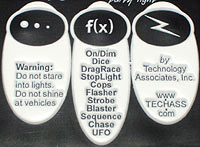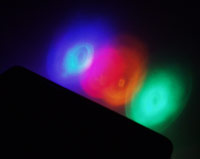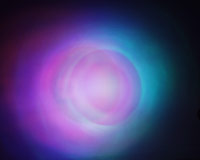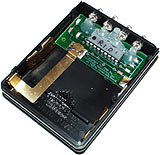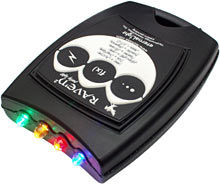
EternaLight Rave'n LED flashlight
Review date: 29 December 2000.Last modified 03-Dec-2011.
LED (Light Emitting Diode) lights are cool.
If you want a small, reliable "carry-around" torch (or, for USAnians, "flashlight"), today's startlingly bright high output LEDs are just the light-bulb you're looking for. They're quite efficient, they come in various colours including a nice white white (as opposed to the yellow-white you get from your average torch bulb), they don't wear out (well, not fast enough that you're likely to care, anyway), and they're far more resistant to physical abuse than filament lamps.
Truly tiny LED lights like the Photon Micro-Light have the advantage that they take up less pocket space than the average show-off car-badge keyfob. But they're not as bright as the ISO Standard Quality Penlight, the two-AA-cell Mini Maglite.
Mag Instrument have sold zillions of Mini Maglites, because they're tough, pretty reliable (the spare bulb in the tail-cap helps) and bright. And they only cost $AU35 or so - lots more than a basic plastic penlight, but much better. The little Maglite Solitaire ($AU25 or so) is about the smallest incandescent torch you don't need to be a secret agent to own, but it eats its single AAA cell pretty speedily and isn't nearly as bright as the Mini Maglite. It's pocketable and popular - I still carry mine around, as well as a Photon Micro-Light - but it's not as useful per gram as the Mini.
This is an inescapable consequence of incandescent-bulb technology. Every kind of incandescent torch relies for its operation on a tiny coil of metal electrically heated to amazing temperatures, and that just isn't a technology for the ages. The minuscule "grain of wheat" bulbs in the baby Maglites are marvels of consumer technology, but their lifespan still isn't fabulous, they're a tad fiddly to replace, and they fail in the same way as every other incandescent bulb - usually, on turn-on.
The reason why ordinary bulbs - of any size - tend to blow when you turn them on is that, cold, the filament resistance is low. When the filament gets to temperature - which only takes a moment - its resistance increases and the current through it settles to a normal level. At the moment of turn-on, though, the low resistance means a lot more current flows than normal, and it's at that moment that a weak spot on the filament's most likely to burn out. The low initial resistance creates a temperature surge that isn't counteracted, in the very short term, by the resistance increase it creates.
Unless some amazing breakthrough's made at some point, this means that incandescent bulbs will always be most prone to failing at the exact moment you've decided you need them. Which is annoying.
And it's also hard to make them last. Halogen bulbs redeposit some of the tungsten that boils off the filament back onto it and so can last longer than ordinary inert gas filled globes, but the only way to greatly extend bulb life is by greatly reducing bulb efficiency. Super-long-life globes are dim, for their wattage. You know that famous light bulb made in Thomas Edison's own lab that's still burning today? Absolutely true, as far as I know (I don't think it's burned out recently), but not indicative of a conspiracy among modern light bulb manufacturers to make their bulbs burn out early. The Edison bulb just has miserable efficiency.
Mini Maglite bulbs last maybe 2 hours from alkaline cells. One set of alkalines ought, from their 2.4 amp hour theoretical capacity, to last for many hours, but the high current drain of the bulb means you get a lot less run time than that - both the output voltage and the cell capacity drops severely when you use alkalines in high-current applications.
If you use rechargeable batteries, giving only 2.4 volts to strain the filament, you may get a bit more lamp life, a bit less light, and quite possibly more battery life, even though nickel cadmium (NiCd) and nickel metal hydride (NiMH) rechargeables don't yet manage more than about half of the spec-sheet capacity of alkalines. Because the rechargeables don't droop under load.
Use lithium AA cells, at about 1.7 volts each, and you get a very bright light and roughly twice the battery life alkalines deliver. But your bulb may well only last an hour.
LEDs are not like this. They don't emit light because they make something very hot. They emit light because of quantum physics - photon emission by negative/positive charge recombination following the motion of electrons across a semiconductor junction. Which sounds like something used to spackle over a hole in a Star Trek script, but which is actually a much better way to turn electrons into photons.
If you don't over-drive an LED, it will give you literally hundreds of thousands of hours of continuous service, and it won't suddenly die at the end of it - it'll just slowly fade over time. And the efficiency of the brighter LEDs available today is already right up there with the best incandescent bulbs. Not as good as fluorescent tubes, but nobody's figured out how to make a teeny tiny focusable fluorescent tube, so fluoros are still only useful for relatively diffuse lighting.
In the future, there'll be commonly available single or multiple LED elements that'll work pretty much like today's incandescent bulbs, and may even fit in the same sockets. Some exist already - LEDCORP make proper, focusable drop-in replacement torch globes, for instance (there's a review of them here), and other such products can be had from places like theledlight.com and LEDtronics. Single-LED "bulbs" are not nearly as bright as incandescent globes, though, and multi-LED assemblies with brightness equal to that of low-powered household light bulbs cost hundreds of times as much, making them products for a rather small niche at the moment.
Since, at the moment, almost all LEDs are still single elements in a plastic capsule and can't individually match incandescent light output, to get an LED light with Mini Maglite-level brightness, you need a light with multiple discrete LEDs.
Enter the EternaLight, made by Technology Associates, whose Internet domain revels in the name techass.com.
The EternaLight is a four-LED light, built into a palm-sized plastic case that looks like a little remote control. An ergonomic masterpiece it is not, but it's a neat package, the buttons on the top are easy to press, and it can stand on its end or its side. It takes three ordinary AA batteries.
There are models with four white LEDs, and other ones with two green and two white, or two red and two white, and the ability to light either or both colours.
Why settle for only two colours, though?
At a glance, the EternaLight Raven looks pretty much like the other models in the range; its lamps are water-clear when they're off, like all current ultra-bright LEDs.
Turn it on, though, and it's a bit more...
...festive.
Its name is rendered by the manufacturers as "Rave'n". As in, "rave", uh, "'n". It's meant to appeal to people who want to adorn themselves with twinkly things and dance like mad for hours on end. But that is not the end of its appeal.
Unlike your standard issue flashing devil-horns and glowing smiley face badges, the Raven is actually good for something besides decoration. You'd want it to be, for the money; it sells for a hair under $US40 from various places, including the place I got mine, glow-bug.com. Sent to Australia, it ended up costing me a tad more than $AU100, landed.
The Raven has a little microcontroller in it, which gives it a lot of flexibility, and a variety of operation modes, from the useful to the silly.
The three control buttons have a nice positive click action, and they're covered with this splash-proof textured rubber membrane. The right hand button is the power switch, the middle one's Function and selects the lighting mode, the left one's the "Adjust" button that changes settings for several modes. All of the white rubber glows in the dark, but no more brightly than a scary six inch skeleton from your local two dollar shop.
Just turn the Raven on and it defaults to full-on flashlight mode. In this mode, the Adjust button dims the light in eight steps, then cycles back to full on.
Because LED efficiency goes to pot as you reduce the current flowing through the diode, the way to efficiently throttle back the brightness of ultra-bright LEDs is by pulse width modulation - changing the "duty cycle" of the LED. Want half brightness? Pulse the LED so that it's on at full power, but only half of the time. Do the pulsing fast enough, and you don't notice it, for the same reason that you don't see flicker when the frames of a movie go past fast enough.
This is how the EternaLight changes its LED brightness, and it works well. In the normal "On" mode, every time you press the Adjust button you drop the brightness by one step, for a total of nine levels. At the lower levels, the pulse frequency is clearly visible if you look straight at the light, but persistence of vision means it's not nearly as noticeable when you're using the light to look at things.
Close up, the four puddles of light are distinctly different and funny looking. This is not the illuminator to use for fine work.
Further away, though, the four beams combine. This is about as combined as they get; pull back further and the light patch just gets bigger and dimmer. But the overall effect is surprisingly close to white light - despite the odd fringes everywhere, colour rendering is pretty darn good.
It's got about half the total beam spread of a Mini Maglite at its maximum flood setting, but the Maglite's beam on that setting provides very uneven illumination. Wind the Maglite to its maximum spot setting and it's got about half the beam spread of the EternaLight.
The EternaLight LEDs have been chosen so that none of them overwhelm the others, and as a torch, this thing actually works rather well. Not as well as a genuine white LED torch, but certainly better than my turquoise Micro-Light, which is stunningly bright for a single-LED keychain baby-light, but which makes everything look like the monster's-eye-view from a B movie.
The LEDs have similar beam widths as well, so the all-on light output wouldn't have a bright red dot in the middle and a big blue halo around the edges, or some such similar oddity.
With all of the LEDs on, anything that gets between the EternaLight and a wall will have a collection of pink, magenta, cyan, yellow and blue shadow-fringes. It's nifty. It's even niftier in some of the other modes.
Goofy modes
For some reason, the Raven's least impressive operation modes are the ones you access first, as you cycle through them with the Function button.
First after the default torch mode is Dice, which lets you press Adjust to have the lights cycle for rather too long and then settle on one pseudo-random colour. Next is DragRace, in which pressing Adjust flashes red twice, then amber, then green. Whoopee.
After that comes StopLight, where the Adjust button cycles through green, amber and red. The traffic lights do not turn blue tomorrow, even though there's a blue light available.
The next underwhelming mode is Cops, in which the red and blue lights blink three times each, in succession, like police flashers. The Adjust button changes the flash rate.
After that, things get better. Flasher just flashes all four lights simultaneously, again with adjustable flash rate.
Strobe mode does what it says, with an adjustable-rate all-four-lights disco-strobe flash. Actually, though, the rapid pulsing of the lower brightness levels of the ordinary torch mode is more useful than the Strobe mode if you want a fast strobe effect, for stopping the motion of a fan or something. The regular strobe is more of a Killer Japanese Seizure Robots sort of flicker, even at its fastest setting.
Blaster flashes each light at very low intensity in turn, in a tricorder-ish fashion, unless you press Adjust - which turns all of the lights on, full power, to blind whatever poor fool just stared at the Raven to see what the twinkly thing was.
Next is Sequence, that just flashes each light in turn at a configurable rate for that basic disco light look. Then there's Chase, that's the inverse - it turns on three lights at a time, sequencing which light's off. Good for odd pulsing coloured shadows.
The last mode's UFO; it runs all four lights, smoothly varying their collective brightness over about a 1.7 second cycle for that alien-mood-lighting look.
When initialising any mode, including the plain all-on mode, the Raven turns all four LEDs on in turn, blue-red-amber-green, just to show off.
Power consumption
In full-on mode, the EternaLight draws about 180 milliamps (mA) at 4.5 volts - 0.81 watts. It won't actually get 4.5V from three AA cells, because of the abovementioned voltage droop, and that much current'll cut the battery capacity as well. But Technology Associates' estimate of 8.5 hours of battery life from alkalines at full power seems sensible enough.
In maximum dimmed mode, the draw from 4.5V drops to only 15ma. This ought to give roughly 160 hours of battery life, assuming AA alkaline cell capacity of 2400 milliamp-hours, but Technology Associates say you'll get 700 hours. This might, perhaps, be true, because of the low current draw, and the fact that the light will keep working even when the batteries are quite flat.
When Blast mode's doing its tricorder twinkle, the light draws only about 1mA, and would probably keep twinkling for the best part of a year, especially if the 700 hour figure's not misleading. Interestingly, pressing the button for the full-power Blast in this mode draws almost 200mA. The LEDs might actually be driven a little harder then than they are in the normal full-on mode, or maybe the microcontroller just sucks another 20mA when the button's down.
If you want to use traffic light mode to activate only one of the lowest-output LEDs - the red and amber ones - you won't get a big battery life drain. For some reason, in this mode the Raven draws about 95mA with either of those lights lit, presumably because of microprocessor activity.
All current bright LEDs reach their maximum efficiency at currents of about 20 to 25 milliamps - for the LED by itself, not for the LED and whatever clever circuitry's controlling it in devices like the Raven. But ones with output colours closer to the violet end of the spectrum (green and blue LEDs in particular) need more volts. High brightness red LEDs want about 1.9 volts, but the brightest blue LEDs want more than twice that.
When the batteries go flat and the supply voltage falls, the EternaLight still works - well, down to 2.8 volts or so, which was as far as I could drop it on my bench supply without fooling with in-line resistors. But it doesn't have enough volts to run the green and blue LEDs, the output from which dwindles to the tiny sparks of light that you get before you've got enough juice for an LED to "fire". The middle two LEDs still run at reasonable brightness, though.
For comparison, a Mini Maglite bulb sucks well over 300mA at 3V - around a watt.
Inside
To replace the Raven's batteries, you remove two little screws and slide the base of the case off. If you've got a small Philips head screwdriver, it's not fiddly at all.
Inside, well, it's not a Swiss watch. This is obviously a hand made product, with solid but somewhat unsightly soldering and copper-strip battery terminals. The central microcontroller's had its identifying information ground off.
The thing works well enough, though, and feels solid.
Light power
It's easy to tell how much power a DC-powered lighting device is consuming. Measure the voltage, measure the current draw, multiply, tah-dah. Finding out how much light it's emitting is considerably harder; you need a proper calibrated light meter, which I, like, totally don't have to hand.
Just eyeballing it, the EternaLight in its stock full-brightness mode seems roughly as bright as a Mini Maglite - the twin-AA-cell ones - adjusted to the same beam size. There's not a big difference. The EternaLight certainly beats the average Mini Maglite brightness - most of the world's Mini Maglites have, at any given moment, partially flattened batteries and bulbs blackened by boiled-off filament molecules, which cut light output considerably. LED lamps are more consistent in their brightness over time.
If you really want to compare the illuminating power of different light sources, though, you open a fairly large can of worms. Allow me to jump into it with you.
Decoding light statistics
You know those cheap hand-held spotlights that are always advertised with blurbs that say things like "One Million Candlepower in the Palm of your Hand", blah blah?
Well, the ads are probably pretty much telling the truth. Even if they're stretching it, the hand-held spots still manage a good few hundred thousand candlepower, no worries.
Now, a million candlepower is also a very impressive brightness figure for a lighthouse.
Since nobody seems to be stampeding to replace expensive lighthouse bulbs with hand held spotlights from K-Mart, you might well suspect there to be something slightly fishy about this statistic. And there is.
The candlepower, also known as the candela, or just candle, is the base measure of luminous intensity. It's equal to the luminous intensity in a given direction of a source which emits monochromatic radiation of frequency 540 x 10^12 hertz and has a radiant intensity in that direction of one six hundred and eighty-third of a watt.
Got that?
Stay with me. Real world examples will be coming.
The trouble with candle-whatevers is that the unit measures intensity in a given direction, and you can thus fudge the numbers for a light-emitting thingy by focussing it better.
Take a relatively weedy light source and focus it tightly - with a big reflector like the ones on hand-held spotlights, for instance - and you'll get an impressive candlepower reading from a light meter held close enough to the source.
The further away you go, of course, the less impressive will be the result, as the light spreads out.
To get a million candlepower out of a cheap spotlight, measure from, say, a metre away. Or closer. To get the same number from a big serious lighthouse, measure from a distance more relevant to the purposes of shipping traffic. As opposed to a distance that's only relevant if you're interested in stunning seagulls sitting on the lighthouse railing.
A more useful unit for comparing the light output of personal illumination thingummies is the lumen. It's the unit of "luminous flux", and it's what you've got when you take a one candlepower light source which sprays its light all over the place, and measure only the light coming out in what physicists call "a unit solid angle". A unit solid angle is one steradian, and a steradian is the solid angle that extends from the centre of a sphere such that it cuts out on the surface of the sphere an area equal to a square with sides the same length as the radius.
The amount of light per steradian will remain the same no matter what distance you measure it at, so there's no way to cheat when measuring lumens. The same light source, better focussed, will still give you more lumens (in the direction it's focussed), but at least the exact same light with the exact same focus level won't give you a different result if you put the meter closer.
Incidentally, the "lux", the unit you see in video camera low light sensitivity specs, is an illuminance value, which tries to give a number indicating how bright, in human-vision terms, is the illumination of a given surface. One lux is defined as equal to the direct illumination on a surface that is everywhere one metre from a uniform point source of one candle intensity. The lux is a real unit, but video camera specs based on it are highly elastic, because there's no standard for how good a picture a camera has to produce at its quoted minimum illumination level.
The trouble with highly focussed zillion candlepower spotlights is that they're not much good as a see-where-you're-going sort of light. They're great as a what's-that-at-the-top-of-that-tree light, as dazzled nocturnal wildlife the world over can testify. But try to use a tightly focussed light of any kind to light your way down stairs and you'll have a painfully bright, night-vision-destroying spot in the middle of your field of vision, but probably no idea about the doggy-doo on the second landing until it's too late.
Maglites, and various other hand-held lights, let you focus the beam yourself, so you can get anything from a quite narrow spot to a quite broad flood. The narrowest beam you can get is determined by the ratio between the filament size and the reflector size - small filament, big reflector, tight beam - and so Mini Maglites can't focus nearly as well as large-reflectored spotlights. But they do pretty nicely.
LEDs have their beam focuser built in. The clear plastic body of all high-intensity LEDs is the lens, and there are practically no lens-equipped LED torches yet, so you're stuck with whatever light angle the LED has natively. The EternaLight has a good beam width for seeing-where-you're-going purposes.
The standard brightness measure for LEDs is the millicandela (mcd) - 1000mcd is one candela. Because it's a candle-thingy unit, you get a better score when the LED's got a narrower beam; all of the most impressively specified LEDs are narrow-beam lamps.
Bog standard red LEDs used for status indicators, with little light output and little focussing as well, may rate as little as 1mcd; the brightest of the bright these days are 10,000mcd or more - considerably more, for some very tight beam models.
Since the millicandela figures vary with focus, you have to factor in the beam width to tell how bright, in lumens, a lamp really is.
If you factor in the input power, as well, you can figure out how completely different light types, like incandescent and LED, really compare.
Efficiency
LEDs are not the magical 100 per cent efficient Light Sources Of Tomorrow, yet. The actual light emitting part of the LED "die" is very small, and it gets hot. The hotter it gets, the lousier the efficiency of the LED becomes and the more rapidly it loses brightness.
If it gets too hot, the LED dies. This is quite likely in LED-abuse situations, because LEDs exhibit a "thermal runaway" phenomenon, in which they pass more and more current the hotter they get, if there's nothing there to stop them.
Go ahead and hook a few dirt cheap low-intensity LEDs up to too many volts and see what happens; you can get some quite unusual colours in the fraction of a second before they expire, and experimenters have managed to turn many old, cheap LEDs into blue ones by the simple expedient of immersing them in liquid nitrogen to deal with the heat!
Comparing the brightness, and efficiency, of LEDs and incandescent globes, has a couple of twists and turns.
The lumen is a unit that depends on the light frequency. You only get the full 683 lumen per watt of light score that the formula might suggest at one frequency - 555 nanometres, the spot in the green spectrum where the average human eye's sensitivity peaks.
That's one watt of output light power, by the way, not one watt of input electricity. Making other frequencies, and making heat instead of light, both result in much lousier lumens-per-input-watt scores for real-world lights.
Most incandescents, and all household light globes, have efficiencies from around 10 to around 20 lumens per watt. Ordinary fluorescent lights achieve something like 70 lumens per watt.
Part of the reason for the lousy efficiency of incandescent lights is that incandescents don't just radiate green light, but give you light all across the visible spectrum. They all behave pretty much like a "black body"; electricity flows, the filament gets very hot and glows, and you get a wide spread of output light frequencies.
Which is good. It gives you accurate colour rendering, because whatever wavelengths of visible light an object can reflect will be present in the light coming from the incandescent bulb.
But the impressive output bandwidth is bad for efficiency, because the further away from 555nm the wavelength of the light is (in either direction), the less sensitive to it will be the eye. The more distant the frequency, the less the light's intensity at that frequency will weight the lumen score.
Most of the reason for incandescents' lousy efficiency, though, is that incandescent lights throw away a ton of energy as heat. This is hardly surprising, when you consider that the whole idea of the incandescent light is that there's a tungsten filament in there that's as close to white hot as it can be got without vaporising - 2500 to 3000 degrees Centigrade.
Nothing in an LED gets white hot, but LEDs still waste energy as heat. Quite rapid advances are being made in LED light output; slower advances are being made in efficiency.
Unsurprisingly, green LEDs with output wavelengths close to the 555 nanometre peak visibility point get the best lumens per watt scores - better than 30, for current models. In the colours you get in the Raven, green, amber, red and blue, and judging not very scientifically by the fact that the EternaLight's green looks about the same brightness as its blue while the other two LEDs look considerably dimmer, you're probably talking something like 15 lumens/watt overall. The Raven doesn't use top-spec mega-brightness green and blue LEDs, because if it did they'd swamp the red and amber output and make everything look turquoise.
White LEDs, in case you care, are special. In practically all other LEDs, you see the LED die itself, directly. In a white LED, a blue LED element drives a phosphor coating that, unlike the phosphor coatings on most fluorescent lamps, emits a nice broad spectrum of mid-green to mid-red light, and passes enough of the original blue to give a pretty darn good spread-spectrum white light.
The most efficient, and most common, fluoros don't do this. They, instead, use only a few flavours of tight-wavelength phosphor whose output adds up to white, but whose aggregate spectrum is missing lots of colours. There are "full spectrum" fluoros that are as good as white LEDs for colour rendering, but most fluoros aim for efficiency rather than prettiness.
An object that primarily reflects wavelengths that the fluoro doesn't emit will seem strangely dark, and possibly a quite different colour from what you expect. Under high efficiency fluorescent light, I for one can't tell the difference between pink and orange Starburst jelly beans. If I turn on an incandescent light, the difference becomes obvious.
White LEDs could perhaps make efficiency gains by using tight-spectrum phosphor as well. Because of their nicer looking broad spectrum two-stage design, though, they end up being only about as efficient as thoroughly ordinary halogen lamps - maybe 15 lumens per watt for the very best white LEDs, or half that for most of the whites out there. And thoroughly ordinary halogens are only about as efficient as the best plain incandescent lamps.
White LEDs still have the advantage of lasting practically forever, being shockproof and not having a hot glass envelope, but for a given amount of light they don't beat a good incandescent.
Just to keep things confusing, by the way, the lumen unit may scale off towards the red and violet ends of the spectrum, but the candela unit doesn't care whether light's actually visible to humans or not.
Overall
Damn, I can write a lot about a flashlight. Look out if I ever get a pair of scissors to review.
While LEDs aren't as groovy as they could be - output per LED can't match incandescent bulb brightness, and they're not stunningly more efficient than incandescents yet either - they're nonetheless a practical light source now.
And the EternaLight Raven, while at first glance rather silly, actually works perfectly well as a normal everyday torch, as well as being a fine toy for the dedicated rave-goer or mere appreciator of gadgets.
Recommended.
You can get a new and improved version of the Rave'n now! I review it here.
Glow-Bug online LED light store
Don Klipstein's main LED page, which I shamelessly plundered for many technical details in this review.


